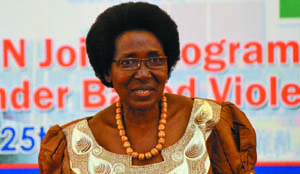 By JOWIT SALUSEKI-
By JOWIT SALUSEKI-
ZAMBIA’S agriculture is mainly dominated by women, yet the gendered assessment report for the Farmer Input Support Programme (FISP) indicates that access to the FISP is still dominated by men.
Despite their contribution to the growth of Zambia’s agriculture sector, women especially those in rural areas continue to be marginalised in accessing land for agriculture and other uses.
Land ownership is an important pre-requisite for socio-economic empowerment worldwide. It is a well known fact that most women in Zambia generally acquire land through marriage or blood ties relationships with men. This situation dis -empowers women, limits their involvement in productive ventures and must be discouraged.
This can be done by developing and implementing policies and strategies that promote women’s access to both statutory and customary land.
Apart from limited access to land, women also face numerous restrictions in accessing agricultural inputs such as improved seeds and fertilisers through subsidised farming inputs offered under the Government’s FISP policy.
According to a report that was commissioned by the Ministry of Gender and Child Development in June 2012, in order to support the gathering, analysis and dissemination of findings on the factors that promote or limit men’s and women’s participation in FISP and how these in turn have differentiated impacts on gender equity, food and nutritional security , income generation and poverty reduction shows a glaring gender disparity in the accessing farming inputs.
An analysis of women and men’s participation in FISP shows that the programme has benefited considerably more men than women despite females constituting the majority of the Zambian population.
Further analysis shows that the populations of both men and women in FISP have steadily grown since 2002, except for Western Province where the numbers have taken a consistently down ward curve.
Over the years, the population of women which started off at 36,791 accounting for 33 per cent of the population in 2002 grew steadily to 74,279 in 2007/08 representing 38.2 per cent of the programme –wide beneficiary population .
A rapid analysis of growth trends in the FISP population suggests that the period 2005/06 witnessed a 55 per cent increase in the number of female beneficiaries from 47,279 to 73,470.
Over the same period, the population of men grew by 50.1 per cent from 88,928 to 143,078. However given that the input were halved during this period ,the real increase in the female population was only 13,095 while that of men was 22,575 representing a growth rate of 27.6 per cent for females and 25.4 per cent for male respectively .
The imbalance in distribution of farming inputs under FISP based on gender, is further observed in the 2008/09 farming season when the number of female beneficiaries had reached 366,776 while that of men grew to 684,886. This means that over-all females represents about half the population of men and about one third of the total population in FISP.
In other words, for every female beneficiary in FISP there are two male counterparts.
Officiating recently in Lusaka at the launch of the Anti-Gender based violence materials and the Gendered assessment of the farmer input support programme, Gender Minister Inonge Wina says she was hopeful to see a positive trend where women will able to access farming inputs just as their male counter-parts.
“As I stand here hopeful of a better Zambia because of all the consented efforts being made in the fight against gender based violence, we are also hopeful that as we continue to engage all the stakeholders in order to achieve gender equality especially in the agricultural sector, where we have more women in subsistence farming who need to be included in the agricultural system for enhanced productivity and national development,” said Ms Wina.
She said the report was envisioned to create a dialogue with stakeholders on key strategic areas and priority interventions for gender equality within the farmer input support programme.
“The FISP report also serve as an indicator that many more programmes in Government need to be engendered and my Ministry will continue to dialogue with different Ministries to ensure that gender is mainstreamed, as per the strategy for engendering the public service. This will ensure that we have gender responsive development that benefits all,” she noted.
Statistics from the FISP report findings shows that men who own land are comparatively less productive than females that own land.
Lack of access to land limits the ability of female small-scale farmers to increase productivity incomes in order to meet their household food security objectives.
This means that investing in improving women’s access to land is likely to increase productivity and overall production by stimulating female farmers to produce more.
In terms of policy reforms, the finds suggests that the Government should reform the customary land tenure system to make it more democratic and gender responsive.
The report recommends that at the core of the beneficiary targeting and selection criteria should be the capacity to graduate farmers so that FISP can become both a wealth and decent employment creation strategy in the agricultural sector capable to lead to poverty reduction and strategic food mechanism.






